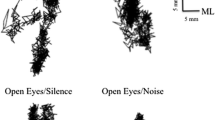Abstract
Sound-evoked activation of the vestibular system has been suggested for a long time, and myogenic potentials have been recorded at the level of different muscular groups while a high intensity sound was applied. The aim of this study was to analyse sound-evoked postural responses in normal subjects and to correlate them with the activation of the vestibular system. Body sway was measured by posturography and elaborated through spectral frequency analysis in 40 healthy volunteers in the basal condition and after applying a sound stimulus monoaurally. Spectral frequency analysis results showed a significant increase, in presence of stimulus, of body sway at low and middle frequencies only on the lateral plane and in the closed-eyes condition. As it seems that these frequency ranges are mainly under vestibular control, our results suggest that sound activates specifically the vestibular system, and posturography during sound stimulation represents an alternative approach to assess vestibular function.

Similar content being viewed by others
References
Alessandrini M, D’Erme G, Bruno E, Napolitano B, Magrini A (2003) Vestibular compensation: analysis of postural re-arrangement as a control index for unilateral vestibular deficit. Neuroreport 23:1075–1079
Alessandrini M, Giacomini P, Sorace F, Bruno E (1998) Postural stabilization after otolithic repositioning for posterior semicircular canal canalolithiasis. Acta Otorhinolaryngol Ital 18:368–372
Bath AP, Harris N, McEwan J, Yardley MP (1964) Effect of conductive hearing loss on the vestibule-collic reflex. Clinic Otolaryngol 24:181–183
Bickford RG, Jacobson JL, Cody DT, Lambert EH (1964) Fast motor systems in man: physiopathology of the sonomotor response. Trans Am Neurol Assoc 89:56–58
Cody DT, Bickford RG (1969) Averaged evoked myogenic responses in normal man. Laryngoscope 79:400–416
Colebatch JG, Halmagyi GM, Skuse NF (1994) Myogenic potentials generated by a click-evoked vestibolo-collic reflex. J Neurol Neurosurg Psychiatry 57:190–197
Dieterich M, Brandt TH, Fries W (1989) Otolith function in man. Results from a case of otolith tullio phenomenon. Brain 112:1377–1392
Ferbert-Viart C, Dubreil C, Duclaux R (1999) Vestibular evoked myogenic potentials in humans: a review. Acta Otolaryngol (Stockh) 119:6–15
Ferbert-Viart C, Soulier N, Dubreil C, Duclax R (1998) Cochleovestibular afferent pathways of trapezius muscle responses to click in human. Acta Otolaryngol (Stockh) 118:6–10
Fetter M (2000) Assessing vestibular function: which tests, when? J Neurol 247:335–342
Giacomini P, Alessandrini M, Magrini A (2002) Long-term postural abnormalities in benign paroxysmal positional vertigo. ORL J Otorhinolaryngol Relat Spec 64:237–241
Giacomini P, Magrini A, Bruno E, Parisi L, Monticone G, Menzinger G, Di Girolamo S, Uccioli L (1996) Postural rearrangement in IDDM patients wilh peripheral neuropathy. Diabetes Care 19:372–374
Giacomini P, Sorace F, Magrini A, Alessandrini M (1998) Spectral analysis in stabilometry for alterations in postural control. Acta Otorhinolaryngol Ital 18:83–87
Kohen-Raz R, Himmelfarb M, Tzur S, Shub Y (1996) An initial evaluation of fatigue and circadian changes as assessed by multiple posturography. Percept Mot Skills 82:547–577
Lowenstein O, Roberts TDM (1951) The localization and anamysis of the responses to vibration from the isolated elasmobranch labyrinth. A contribution to the problem of the evaluation of hearing in vertebrates. J Physiol (Lond) 114:471–489
Minor LB, Salomon D, Zinreich JS, Zee DS (1998) Sound and/or pressure-induced vertigo due to bone dehiscence of the superior semicircular canal. Arch Otolaryngol Head Neck Surg 124:249–258
Nagakawa H, Ohashi N, Watanabe Y, Mizukashi K (1993) The contribution of proprioception to posture control in normal subjects. Acta Otolaryngol (Stockh) [Suppl] 504:112–116
Norrè ME, Forrez G, Beckers A (1986) Posture testing (posturography) in diagnosis of peripheral vestibular pathology. Arch Otorhinolaryngol 243:186
Norrè ME (1993) Sensory interaction testing in platform posturography. J Laryngol Otol 107:496–501
Russolo M (2002) Sound-evoked postural responses in normal subjects. Acta Otolaryngol 122:21–27
Saidel WM, Popper AN (1986) The saccule may be the transducer for directional hearing of non strariophysine teleosts. Exp Brain Res 50:149–152
Townsend GL, Cody DT (1971) The averaged inion response evoked by acoustic stimulation: its relation to the saccule. Ann Otol Rhinol Laryngol 80:121–131
Tullio P (1928) L’orecchio. L. Cappelli, Bologna
Uchino Y, Sato H, Sasaki M, Imagawa M, lkegami H, Isu N, Graf W (1997) Sacculocollic reflex in cats. J Neurophysiol 77:3003–3012
Valli P, Valli S, Vicini C (2001) Attualità in tema di potenziali evocati vestibolari: dal laboratorio alla pratica clinica. In: XVIII giornate italiane di Otoneurologia
Watson SRD, Colebatch JG (1998) Vestibular-evoked electromyographic responses in soleus: a comparison between click and galvanic stimulation. Exp Brain Res 119:504–510
Wo C, Young Y, Murofushi T (1999) Tone burst-evoked myogenic potentials in human neck flexor and exstensors. Acta Otolaryngol (Stockh) 119:74l–744
Author information
Authors and Affiliations
Corresponding author
Rights and permissions
About this article
Cite this article
Alessandrini, M., Lanciani, R., Bruno, E. et al. Posturography frequency analysis of sound-evoked body sway in normal subjects. Eur Arch Otorhinolaryngol 263, 248–252 (2006). https://doi.org/10.1007/s00405-005-0965-7
Received:
Accepted:
Published:
Issue Date:
DOI: https://doi.org/10.1007/s00405-005-0965-7




